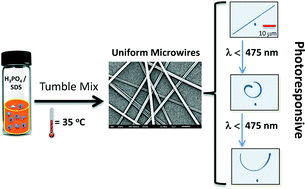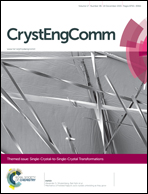Chemical reaction method for growing photomechanical organic microcrystals†
Abstract
(E)-3-(Anthracen-9-yl)acrylic acid (9-AYAA) exhibits a strong photomechanical response in bulk crystals but is challenging to grow in microcrystalline form. High quality microcrystals of this molecule could not be grown using techniques like sublimation, reprecipitation, and the floating drop method. If the tertbutyl ester of 9-AYAA is used as a starting material, however, high quality, size-uniform microwires could be grown via acid catalyzed hydrolysis. 9-AYAA microwires with uniform length and thickness were produced after a suspension of (E)-tert-butyl 3-(anthracen-9-yl)acrylate ester microparticles was tumble-mixed in a mixture of phosphoric acid and sodium dodecyl sulfate at 35 °C. The dependence of the results on temperature, surfactant and precursor concentration, and mixing mode was investigated. This chemical reaction-growth method was extended to grow microplates of 9-anthraldehyde using the corresponding acylal as the starting material. Under 475 nm irradiation, the 9-AYAA microwires undergo a photoinduced coiling–uncoiling transition, while the 9-anthraldehyde microplates undergo a folding–unfolding transition.

- This article is part of the themed collection: Single-Crystal-to-Single-Crystal Transformations

 Please wait while we load your content...
Please wait while we load your content...